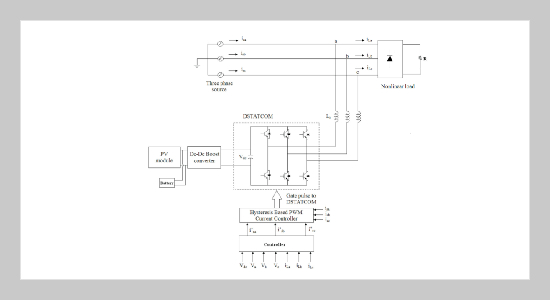REFERENCES
- [1] Baggini, A., Handbook on Power Quality, New Jersey USA, John Wiley & Sons (2008).
- [2] Moreno-Munoz, A., Power Quality: Mitigation Technologies in a Distributed Environment, London, U.K, Springer-Verlag (2007).
- [3] Singh, M., Khadkikar, V., Chandra, A. and Varma, R. K., “Grid Interconnection of Renewable Energy Sources at the Distribution Level with Power Quality Improvement Features,” IEEE Transactions on Power Delivery, Vol. 26, No. 1, pp. 307315 (2011).
- [4] Kamatchi Kannan, V. and Rengarajan, N., “Photovoltaic Based Distribution Static Compensator for Power Quality Improvement,” International Journal of Electrical Power & Energy Systems, Vol. 42, No. 1, pp. 685692 (2012).
- [5] Pinto, J. P., Pregitzer, R., Monteiro, L. F. C. and Afonso, J. L., “3-Phase 4-Wire Shunt Active Filter with Renewable Energy Interface,” Presented at the Conference IEEE Renewable Energy & Power Quality, Seville: Spain (2007).
- [6] Ghosh, A. and Ledwich, G., Power Quality Enhancement Using Custom Power Devices, Norwell, USA, Kluwer (2002).
- [7] Hingorani, N. G., “Introducing Custom Power,” IEEE Spectrum, Vol. 32, No. 6, pp. 4148 (1995).
- [8] Masand, D., Jain, S. and Agnihotri, G., “Control Strategies for Distribution Static Compensator for Power Quality Improvement,” IETE Journal of Research, Vol. 54, No. 6, pp. 421428 (2008).
- [9] Miller, T. J. E., Reactive Power Control in Electric Systems, Toronto, Ontario, Canada, Wiley (1982).
- [10] Akagi, H., Watanabe, E. H. and Aredes, M., Instantaneous Power Theory and Applications to Power Conditioning, USA, John Wiley & Sons (2007).
- [11] Jou, H. L., Wu, K. D., Li, C. H. and Huang, M. S., “Noval Power Converter Topology for Three Phase Four Wire Hybrid Power Filter,” IET Power Electronics, Vol. 1, No. 1, pp. 164173 (2008).
- [12] Milanes, M. I., Cadaval, E. R. and Gonzalez, F. B., “Comparison of Control Strategies for Shunt Active Power Filters in Three-Phase Four-Wire Systems,” IEEE Transaction on Power Electronics, Vol. 22, No. 1, pp. 229236 (2007).
- [13] Furuhashi, T., Okuma, S. and Uchikawa, Y., “A Study on the Theory of Instantaneous Reactive Power,” IEEE Transactions on Industrial Electronics, Vol. 37, No. 1, pp. 8690 (1990).
- [14] Kim, H., Blaabjerg, F., Jensen, B. B. and Choi, J., “Instantaneous Power Compensation in Three-Phase Systems by Using p-q-r Theory,” IEEE Transactions on Power Electronics, Vol. 17, No. 5, pp. 701709 (2002).
- [15] Chandra, A., Singh, B., Singh, B. N. and Al-Haddad, K., “An Improved Control Algorithm of Shunt Active Filter for Voltage Regulation, Harmonic Elimination, Power-Factor Correction, and Balancing of Nonlinear Loads,” IEEE Transactions on Power Electronics, Vol. 15, No. 3, pp. 495507 (2000).
- [16] Widrow, B. and Lehr, M. A., “30 Years of Adaptive Neural Networks: Perceptron, Madaline, and Back Propagation,” Proceedings of IEEE, Vol. 78, No. 9, pp. 14151442 (1990).
- [17] Singh, B. N., “Design and Digital Implementation of Active Filter with Power Balance Theory,” IEE Proceedings on Electric Power Applications, Vol. 152, No. 5, pp. 11491160 (2005).
- [18] Singh, B. and Kumar, S., “Control of DSTATCOM Using Icos� Algorithm,” IEEE Conference in Industrial Electronics IECON’09, pp. 322327 (2009).
- [19] Bhuvaneswari, G. and Nair, M. G., “Design, Simulation, and Analog Circuit Implementation of a ThreePhase Shunt Active Filter Using the Icos� Algorithm,” IEEE Transactions on Power Delivery, Vol. 23, No. 1, pp. 12221235 (2008).
- [20] Altas, H. and Sharaf, A. M., “A Photovoltaic Array Simulation Model for MATLAB Simulink GUI Environment,” Proceedings of ICCEP ’07, pp. 341345 (2007).
- [21] Park, M. and Yu, I. K., “A Novel Real-Time Simulation Technique of Photovoltaic Generation Systems using RTDS,” IEEE Transaction on Energy Conversion, Vol. 19, No. 1, pp. 164169 (2004).
- [22] http://www.ulsolar.com.cn/download/ulica2008PRD mono.pdf.
- [23] Elshaer, M., Mohamed, A. and Mohammed, O., “Smart Optimal Control of DC-DC Boost Converter in PV Systems,” Transmission and Distribution Conference and Exposition: Latin America (T&D-LA), 2010 IEEE/PES, pp. 403410 (2010).
- [24] Jiang, W., Zhou, Y. F. and Chen, J. N., “Modeling and Simulation of Boost Converter in CCM and DCM,” IEEE Conference on Power Electronics and Intelligent Transportation System (PEITS), pp. 288291 (2009).
- [25] Gopal, V. R. and Singh, B., “Decoupled Electronic Load Controller for Offgrid Generators in small Hydro power Generation,” International Journal of Emerging Electric Power Systems, Vol. 12, No. 1, pp. 112 (2011).
















